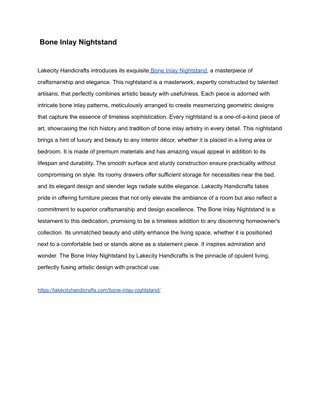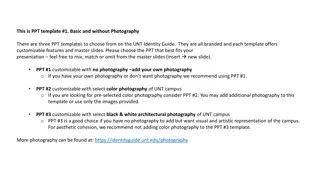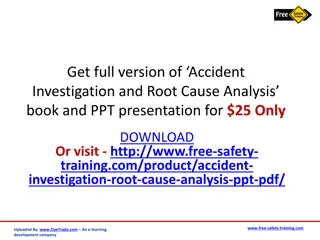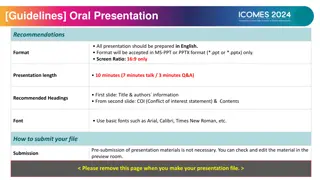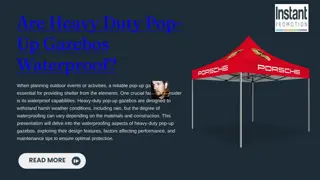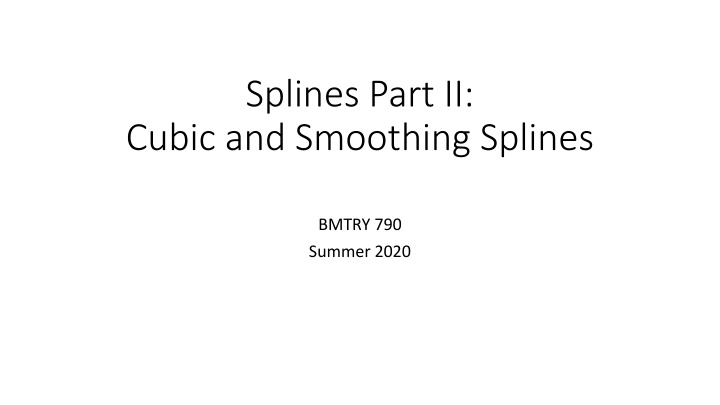
Cubic and Natural Cubic Splines for Smoothing and Regression
Explore cubic splines and natural cubic splines for smoothing and regression in statistics. Learn about the properties, constraints, basis functions, and fitting techniques of these spline models.
Download Presentation

Please find below an Image/Link to download the presentation.
The content on the website is provided AS IS for your information and personal use only. It may not be sold, licensed, or shared on other websites without obtaining consent from the author. If you encounter any issues during the download, it is possible that the publisher has removed the file from their server.
You are allowed to download the files provided on this website for personal or commercial use, subject to the condition that they are used lawfully. All files are the property of their respective owners.
The content on the website is provided AS IS for your information and personal use only. It may not be sold, licensed, or shared on other websites without obtaining consent from the author.
E N D
Presentation Transcript
Splines Part II: Cubic and Smoothing Splines BMTRY 790 Summer 2020
Cubic Splines Recall, we defined a cubic spline as follows Given a < 1 < 2 < < K< b, a function h is a cubic spline if 1. On each interval (a , 1), ( 1, 2), , ( K, b), h is a cubic polynomial 2. The polynomial pieces fit together at points i(knots) s.t. h itself and its first and second derivatives are continuous at each i, and hence on the whole [a,b] Thus, we want the function y = f(x) that is: a cubic polynomial between every pair of knots i , i+1 continuous at each knot. has continuous first and second derivatives at each knot.
Cubic Splines We can write f(x) in terms of K + 3 basis functions
Natural Cubic Splines Polynomial fits tend to be erratic at the boundaries of x This is even worse for cubic splines Natural cubic splines ameliorate this problem by adding additional constraints A cubic spline f is called a natural cubic spline if its 2ndand 3rdderivatives are 0 at a and b Implies that f is linear on extreme intervals
Natural Cubic Splines This additional constraint provides 4 additional degrees of freedom Result is that cubic spline with K knots represented by K basis functions Can be used for more knots if needed Basis functions for a natural cubic spline start with what we already have from cubic splines ( ) X ( ) X ( ) X ( ) X = = = 1, , N N x N d d + 1 2 2 1 k k K ( ) ( ) 3 + 3 + X X ( ) X k K = d where k K k
Fitting a Regression Spline Recall the set of basis functions we described for the continuous piecewise model is an example of the truncated power basis The truncated power basis is nice because: Conceptual simplicity Linear model is nested inside it, leading to simple tests of the null hypothesis of linearity However, it has computational/numerical issues.. It is inefficient and can lead to overflow and nearly singular matrix problems As a results, the fit for a cubic spline is generally fit using a B-spline basis More complicated Numerically more stable and efficient
Fitting a Regression Spline in R Consider, the set of all cubic splines (with given knots) forms a vector space B-spline basis functions form a basis for this vector space i.e. we can write any spline uniquely as a linear combination of these basis functions. When you write a spline curve as a linear combination of basis functions in this way, it's called a B-spline" R provides a function for fitting B-splines
Fitting a Regression Spline in R R also provides a function to compute a basis for the natural cubic splines works similarly to the B-spline approach for cubic splines But there isn t an option to change the degree However the natural spline has m+ K - 4 degrees of freedom Therefore a natural cubic spline with K knots has K degrees of freedom
Mean and Variance Because the basis functions are fixed, all standard approaches to inference for regression are valid So we let L = X(X X)-1X denote the projection matrix, ( ) ( ) ( ) ( L LL = L E f x f x ( ) ) 1 ( ) = ' ' L Var f x 2 y y = i i CV 1 n 1 l i ii Furthermore, extensions to logistic regression, Cox proportional hazards regression, etc., are straightforward
Spline Parameters We also have choices regarding degree of the spline and location and number of knots Unless there is a reason to choose specific knot locations, the default is to use quantiles of the observed distribution of x We can use an internal selection approach to select the number of knots Cross-validation K-fold GCV Bootstrap approach
Check for Non-Linearity We also want to check whether or not use of a spline (i.e. non- linearity) is appropriate Since the linear model is technically nested within the spline model, we can use an ANOVA approach
Thermoregulation During Surgery Occurrence of hypothermia during surgery is associated with increased complication rate Hypothermia defined as temperature < 36.0oC The goal of the study was to identify patient/hospital factors associated with hypothermia to identify potential interventions Information collected in the study included Patient characteristics (gender, age, BMI) Procedural characteristics (surgery, anesthesia type, EBL, Total IV Fluids) Hospital characteristics (mattress temperature, OR temperature, OR humidity) Time in surgery
Fitting a Regression Spline in R (If we want) we can develop a cubic spline model by hand based on transformations defined by the basis functions What are the basis functions for a cubic spline with K = 3 knots?
R-Code to Hand Fit the Model temp<-read.csv("H:\\public_html\\BMTRY790_Spring2023\\Datasets\\Thermoreg.csv") temp<-temp$Temp time<-temp$Time qtime<-quantile(time)[2:4] qtime 25% 50% 75% 52.00 116.50 193.75 It1<-ifelse(time>qtime[1], 1, 0); It2<-ifelse(time>qtime[2], 1, 0); It3<-ifelse(time>qtime[3], 1, 0) csx<-cbind(temp, time, time^2,time^3,It1*(time-qtime[1])^3,It2*(time-qtime[2])^3,It3*(time-qtime[3])^3) colnames(csx)<-c("temp","h1","h2","h3","h4","h5","h6") csx<-as.data.frame(csx) csx temp h1 h2 h3 h4 h5 h6 1 37.00000 0 0 0 0 0 0 2 36.76667 0 0 0 0 0 0 3 36.46667 0 0 0 0 0 0 ... 369 36.63333 455 207025 94196375 65450827 39304000 17881958.375 370 36.60000 455 207025 94196375 65450827 39304000 17881958.375 371 36.60000 458 209764 96071912 66923416 40353607 18504486.125
R-Code to Hand Fit the Model lmfit1<-lm(temp ~ ., data=csx) summary(lmfit1) Call: lm(formula = temp ~ ., data = csx) Residuals: Min 1Q Median 3Q Max -3.11383 -0.34001 -0.04953 0.30128 2.24896 Coefficients: Estimate Std. Error t value Pr(>|t|) (Intercept) 3.649e+01 9.025e-02 404.304 < 2e-16 *** h1 -1.839e-02 1.314e-02 -1.399 0.16263 h2 3.124e-04 3.885e-04 0.804 0.42182 h3 -1.350e-06 3.045e-06 -0.443 0.65780 h4 2.142e-07 3.657e-06 0.059 0.95333 h5 1.860e-06 9.323e-07 1.995 0.04680 * h6 -8.711e-07 3.248e-07 -2.682 0.00765 ** --- Residual standard error: 0.5516 on 363 degrees of freedom; Multiple R-squared: 0.03978, Adjusted R-squared: 0.0239 F-statistic: 2.506 on 6 and 363 DF, p-value: 0.02175
What Does the Model Look Like? ( ) f X ( ) 3 + Our model: = 36.4 0.018 + + 2 6 7 0.0003 1.35 2.14 52 time time e e time ( ) ( ) 3 + 3 + 6 7 1.86 116.5 8.71 194 e time e time And predictions at 30, 90, 150, or 210 minutes?
Fitting a Regression Spline in R We can fit by hand, but R has several package/functions that can fit splines splines package (installed with base package but must be loaded) bs() fits B-splines ns() fits natural cubic splines (again using B-spline approach) By default, bs uses degree=3, knots at evenly spaced quantiles Does not return a column for the intercept rms package: rcs() fits natural cubic splines
Fitting Cubic Spline Using bs() bsfit1<-bs(time, df=6) round(bsfit1, 4) 1 2 3 4 5 6 [1,] 0.0000 0.0000 0.0000 0.0000 0.0000 0.0000 [2,] 0.0000 0.0000 0.0000 0.0000 0.0000 0.0000 [3,] 0.0000 0.0000 0.0000 0.0000 0.0000 0.0000 [368,] 0.0000 0.0000 0.0000 0.0003 0.0333 0.9664 [369,] 0.0000 0.0000 0.0000 0.0003 0.0333 0.9664 [370,] 0.0000 0.0000 0.0000 0.0000 0.0000 1.0000 attr(,"degree") [1] 3 attr(,"knots") 25% 50% 75% 52.00 116.50 193.75 attr(,"Boundary.knots") [1] 0 458 attr(,"intercept") [1] FALSE attr(,"class") [1] "bs" "basis" "matrix"
Fitting Cubic Spline Using bs() ### To actually fit a model of temperature over time lmfit2<-lm(temp ~ bs(time, df=6)) summary(lmfit2) Call: lm(formula = temp ~ bs(time, df = 6)) Residuals: Min 1Q Median 3Q Max -3.11285 -0.33950 -0.05206 0.30212 2.24753 Coefficients: Estimate Std. Error 36.48654 0.09025 404.304 < 2e-16 *** -0.31868 0.22777 -1.399 -0.40185 0.16942 -2.372 0.22579 0.15958 1.415 -0.72189 0.24724 -2.920 0.42008 0.35543 1.182 -0.24603 0.26312 -0.935 t value Pr(>|t|) (Intercept) bs(time, df = 6)1 bs(time, df = 6)2 bs(time, df = 6)3 bs(time, df = 6)4 bs(time, df = 6)5 bs(time, df = 6)6 --- Signif. codes: 0 *** 0.001 ** 0.01 * 0.05 . 0.1 1 0.16263 0.01822 * 0.15797 0.00372 ** 0.23803 0.35039 Residual standard error: 0.5516 on 363 degrees of freedom; Multiple R-squared: 0.03978, Adjusted R-squared: 0.0239 F-statistic: 2.506 on 6 and 363 DF, p-value: 0.02175
Fitting Natural Cubic Spline Using ns() nsfit1<-ns(time, df=6) round(nsfit1, 4) 1 2 3 4 5 6 [1,] 0.0000 0.0000 0.0000 0.0000 0.0000 0.0000 [2,] 0.0000 0.0000 0.0000 0.0000 0.0000 0.0000 [3,] 0.0000 0.0000 0.0000 0.0000 0.0000 0.0000 [368,] 0.0000 0.0000 0.0000 -0.1453 0.3721 0.7732 [369,] 0.0000 0.0000 0.0000 -0.1453 0.3721 0.7732 [370,] 0.0000 0.0000 0.0000 -0.1631 0.3736 0.7896 attr(,"degree") [1] 3 attr(,"knots") 16.66667% 33.33333% 50% 66.66667% 83.33333% 24.33333 73.00000 115.00000 163.00000 229.33333 attr(,"Boundary.knots") [1] 0 458 attr(,"intercept") [1] FALSE attr(,"class") [1] "ns" "basis" "matrix"
Fitting Natural Cubic Spline Using ns() ### To actually fit a model of temperature over time lmfit3<-lm(temp ~ ns(time, df=6)) summary(lmfit3) Call: lm(formula = temp ~ ns(time, df = 6)) Residuals: Min 1Q Median 3Q Max -3.1635 -0.3443 -0.0540 0.2772 2.2783 Coefficients: Estimate 36.47394 0.08564 -0.23605 0.16451 0.15829 0.17293 -0.15983 0.14387 -0.06279 0.19805 -0.41944 0.26097 0.20319 0.20010 Std. Error t value Pr(>|t|) (Intercept) ns(time, df = 6)1 ns(time, df = 6)2 ns(time, df = 6)3 ns(time, df = 6)4 ns(time, df = 6)5 ns(time, df = 6)6 --- Signif. codes: 0 *** 0.001 ** 0.01 * 0.05 . 0.1 1 425.903 <2e-16 *** -1.435 0.915 -1.111 -0.317 -1.607 1.015 0.152 0.361 0.267 0.751 0.109 0.311 Residual standard error: 0.5534 on 363 degrees of freedom; Multiple R-squared: 0.0335, Adjusted R-squared: 0.01752 F-statistic: 2.097 on 6 and 363 DF, p-value: 0.05293
Fitting Natural Cubic Spline Using ns() ### To actually fit a model of temperature over time lmfit3<-lm(temp ~ ns(time, df=6)) summary(lmfit3) Call: lm(formula = temp ~ ns(time, df = 6)) Residuals: Min 1Q Median 3Q Max -3.1635 -0.3443 -0.0540 0.2772 2.2783 Coefficients: Estimate 36.47394 0.08564 -0.23605 0.16451 0.15829 0.17293 -0.15983 0.14387 -0.06279 0.19805 -0.41944 0.26097 0.20319 0.20010 Std. Error t value Pr(>|t|) (Intercept) ns(time, df = 6)1 ns(time, df = 6)2 ns(time, df = 6)3 ns(time, df = 6)4 ns(time, df = 6)5 ns(time, df = 6)6 --- Signif. codes: 0 *** 0.001 ** 0.01 * 0.05 . 0.1 1 425.903 <2e-16 *** -1.435 0.915 -1.111 -0.317 -1.607 1.015 0.152 0.361 0.267 0.751 0.109 0.311 Residual standard error: 0.5534 on 363 degrees of freedom; Multiple R-squared: 0.0335, Adjusted R-squared: 0.01752 F-statistic: 2.097 on 6 and 363 DF, p-value: 0.05293
Using CV to Find Best DF ### K fold cross-validation set.seed(12345) Kfoldcv<-function(y, x, K, k) { n<-length(y) cv.ids<-sample(1:n, n, replace=F) y2<-y[cv.ids]; x2<-x[cv.ids] vecmat<-matrix(1:n, nrow=n/K, ncol=K, byrow=F) cv.err<-matrix(nrow=K, ncol=k) for(i in 1:K) { ids<-vecmat[,i] try<-y2[-ids]; tsy<-y2[ids] trx<-x2[-ids]; tsx<-x2[ids] for (j in 1:k) { fit<-lm(try ~ ns(trx, df=(j+3))) cv.err[i,j]<-mean((y2[ids]-predict(fit, newdata=data.frame(trx=tsx)))^2) } } return(colMeans(cv.err)) } Kfoldcv(y=temp, x=time, K=10, k=7) [1] 0.3091958 0.3111311 0.3111485 0.3114347 0.3103196 0.3097953 0.3113089
Using CV to Find Best DF ### Leave one out cross-validation set.seed(12345) LOOcv<-function(y, x, k) { n<-length(y) cv.err<-matrix(nrow=n, ncol=k) for(i in 1:n) { try<-y2[-i]; tsy<-y2[i] trx<-x2[-i]; tsx<-x2[i] for (j in 1:k) { fit<-lm(try ~ ns(trx, df=(j+3))) cv.err[i,j]<-(y2[i]-predict(fit, newdata=data.frame(trx=tsx)))^2 } } return(colMeans(cv.err)) } LOOcv(y=temp, x=time, k=7) [1] 0.3094580 0.3099629 0.3107523 0.3114506 0.3122655 0.3101377 0.3116486
Checking Non-Linearity Assumptions ### Also want to evaluate need for non-linear approach for modeling temperature over time lmfit3<-lm(temp ~ ns(time, df=4)) lmfitlin<-lm(temp ~ time) anova(lmfitlin, lmfit3) Analysis of Variance Table Model 1: temp ~ time Model 2: temp ~ ns(time, df = 4) Res.Df RSS Df Sum of Sq 1 368 115.01 2 365 111.73 3 3.2792 3.5708 0.01428 * --- Signif. codes: 0 *** 0.001 ** 0.01 * 0.05 . 0.1 1 F Pr(>F)
Fitting Cubic Spline Using rcs() nsfit2<-rcs(time, df=5) round(nsfit2, 4) time time' time'' time'' [1,] 0.0000 0.0000 0.0000 0.0000 [2,] 0.0000 0.0000 0.0000 0.0000 [3,] 0.0000 0.0000 0.0000 0.0000 [368,] 455 361.1749 323.3341 123.7762 [369,] 455 361.1749 323.3341 123.7762 [370,] 458 365.1780 326.9671 125.3089 attr(,"class") [1] "rms" attr(,"name") [1] "time" attr(,"label") [1] "time" attr(,"assume") [1] "rcspline" attr(,"assume.code") [1] 4 attr(,"parms") [1] 2.0 13.0 87.2 170.4 380.6 attr(,"nonlinear") [1] FALSE TRUE TRUE TRUE attr(,"colnames") [1] "time" "time'" "time''" "time'''"
Fitting Cubic Spline Using rcs() ### RCS model of temperature over time lmfit4<-ols(temp~rcs(time,5)) lmfit4 Linear Regression Model ols(formula = temp ~ rcs(time, 5)) Model Likelihood Discrimination Ratio Test Indexes 370 LR chi2 12.32 R2 0.033 sigma 0.5521 d.f. 4 R2 adj 0.022 d.f. 365 Pr(> chi2) 0.0151 g 0.114 Obs Residuals Min 1Q Median 3Q Max -3.1656 -0.3317 -0.0538 0.2846 2.2698 Coef S.E. t Pr(>|t|) Intercept 36.4941 0.0838 435.30 <0.0001 time -0.0173 0.0053 -3.28 0.0011 time' 1.5600 0.4474 3.49 0.0005 time'' -1.8612 0.5330 -3.49 0.0005 time''' 0.3735 0.1075 3.47 0.0006
Checking Non-Linearity Assumptions ### Checking non-linear assumptions lmfit4<-ols(temp~rcs(time,5)) anova(lmfit3, ss=FALSE) Analysis of Variance Response: temp Factor F d.f. time 3.09 4 0.0160 Nonlinear 4.08 3 0.0072 TOTAL 3.09 4 0.0160 P Error d.f.: 365
Smoothing Splines Fixed df splines are useful but they are not truly nonparametric. The choice regarding number of knots and where they are located are essentially parametric and impact the fit. Additionally, if knots are placed at the quantiles of x, models are not truly nested (when comparing different numbers of knots) which complicates hypothesis testing
Smoothing Splines Avoids the knot selection completely by using a maximal set of knots The complexity of the fit is controlled by regularization Setup: among all functions f(x) with two continuous derivatives, find one that minimizes the penalized residual sum of squares ( ) 2 ( ) ( ) ( ) f x ( ) t 2 N = + '' , RSS f y f dt i i = 1 i = smoothing parameter The second term penalizes curvature in the function
Smoothing Splines The solution is a natural cubic spline with knots at the unique values of the xi, i = 1,..., N The penalty term translates to a penalty on the spline coefficients that shrinks towards the linear fit ( ) f x ( ) x N = , N j j = 1 j ( ) x = N N are an -dimensional set of natural cubic spline N where ij j i basis functions ( ) ( = ) ( ) ( ) t N ( ) t dt T + = '' j '' k T y N y N , RSS N with N N jk ( ) 1 = + T T N N N y N
Smoother Matrix The predicted outcome y on our set of cubic basis splines determined from the expression ( N y y = S ) 1 = + T T N N N N y Here S is called the smoother matrix and we can see that y is linear in S , where S only depends xiand . The effective degrees of freedom for S are df ( ) = S trace
Penalty Parameter Recall is called the smoothing parameter (like ridge regression) = 0 f can be any function that interpolates the data results in the least squares fit = So the choice of controls the smoothness of our spline model We can choose using something like a cross validation approach Based on choiced of Or based on df (1 < df < n)
Fitting Temperature Data With Smoothing Spline ### First consider appropriate choice of lambda using cross-validation df<-seq(1.5, 30, by=0.25); spar<-seq(0, 1, length.out=length(df)) cv.df<-c(); cv.spar<-c() for (i in 1:length(df)) { cv.df<-append(cv.df, smooth.spline(time, temp, df=df[i])$cv.crit) cv.spar<-append(cv.spar, smooth.spline(time, temp, spar=spar[i])$cv.crit) } round(cv.df, 3) [1] 0.314 0.314 0.314 0.315 0.315 0.315 0.315 0.315 0.315 0.315 0.314 0.314 [109] 0.327 0.327 0.327 0.328 0.328 0.328 0.328 round(cv.spar, 3) [1] 0.363 0.363 0.362 0.361 0.361 0.360 0.359 0.358 0.358 0.357 0.356 0.355 [109] 0.310 0.310 0.310 0.311 0.311 0.311 0.311 which(cv.df==min(cv.df)) [1] 24 which(cv.spar==min(cv.spar)) [1] 106
Fitting Temperature Data With Smoothing Spline ### Model based on best df bdf<-df[which(cv.df==min(cv.df))] smspfit1<-smooth.spline(time, temp, df=bdf) smspfit1 Call: smooth.spline(x = time, y = temp, df = bdf) Smoothing Parameter spar= 0.9200563 lambda= 0.003109123 (12 iterations) Equivalent Degrees of Freedom (Df): 7.24909 Penalized Criterion: 69.75926 GCV: 0.3099457 ### Model based on best spar (again used to calculate lambda) bspar<-spar[which(cv.spar==min(cv.spar))] smspfit2<-smooth.spline(time, temp, spar=bspar) smspfit2 Call: smooth.spline(x = time, y = temp, spar = bspar) Smoothing Parameter spar= 0.9210526 lambda= 0.003159333 Equivalent Degrees of Freedom (Df): 7.224468 Penalized Criterion: 69.77451 GCV: 0.3099465
Fitting Temperature Data With Smoothing Spline ### Model based on best df names(smspfit1) [1] "x" "y" "w" "yin" "data" "lev" [7] "cv.crit" "pen.crit" "crit" "df" "spar" "lambda" [13] "iparms" "fit" "call smspfit1$w [1] 31 2 1 1 3 2 3 1 2 3 3 1 3 1 2 1 1 2 2 1 1 2 1 1 2 [26] 2 1 1 2 1 3 2 1 1 1 1 1 4 1 1 1 1 2 1 1 1 2 2 2 4 [51] 1 2 2 1 2 3 2 3 3 1 2 1 6 6 2 1 1 1 2 1 4 2 2 2 1 [76] 1 1 3 1 2 1 1 3 1 3 1 1 1 2 1 4 1 1 5 1 1 1 2 1 2 [101] 1 1 4 2 3 2 2 2 5 2 4 1 1 1 5 1 1 1 1 1 2 1 2 1 2 [126] 1 1 1 2 1 1 2 2 2 2 2 1 1 2 2 1 2 2 1 1 1 2 1 1 3 [151] 1 1 1 1 3 1 1 1 1 1 1 2 2 1 2 1 1 2 1 3 2 1 1 1 1 [176] 1 1 1 1 1 1 1 1 1 1 1 1 1 1 1 1 1 1 1 1 1 1 1 1 1 [201] 1 2 1 1 1 1 1 1 1 1 1 2 1 smspfit1$lambda [1] 0.003109123
Fitting Temperature Data With Smoothing Spline ### Model based on best df smspfit1$fit $knot [1] 0.000000000 0.000000000 0.000000000 0.000000000 0.006550218 0.010917031 [7] 0.015283843 0.021834061 0.028384279 0.034934498 0.043668122 0.054585153 [91] 0.707423581 0.720524017 0.740174672 0.770742358 0.788209607 0.829694323 [97] 0.838427948 0.868995633 0.882096070 0.906113537 0.917030568 0.934497817 [103] 1.000000000 1.000000000 1.000000000 1.000000000 $nk [1] 102 $min [1] 0 $range [1] 458
Fitting Temperature Data With Smoothing Spline ### Model based on best df smspfit1$fit .... $coef [1] 36.41848 36.41223 36.40181 36.38740 36.37322 36.35742 36.34039 36.32245 [9] 36.30247 36.28491 36.27114 36.26144 36.25429 36.24913 36.24489 36.24087 [89] 36.45447 36.46868 36.47576 36.47654 36.46941 36.45671 36.43904 36.42634 [97] 36.41047 36.40015 36.38972 36.37216 36.36144 36.35366 attr(,"class") [1] "smooth.spline.fit"







